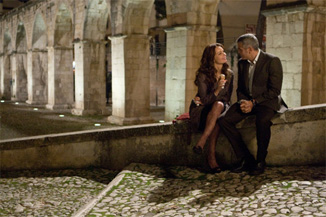Hidden Gems: The American
By Kyle Lee
March 31, 2016
BoxOfficeProphets.com

Based on British author Martin Booth’s spy novel A Very Private Gentleman, The American follows Jack (Clooney) as he flees Sweden, running from men who are trying to kill him. We’re not sure why, but Jack’s handler Pavel (Johan Leysen) says it’s because Jack has lost his edge now that he’s getting older. Jack goes to where Pavel sets up a safe house in Italy, but a paranoid Jack runs away on his own to a different town. He’s eventually set up with a job to make a gun for Mathilde (Thekla Reuten, the innkeeper from In Bruges). While in the town, Jack becomes involved with local prostitute Clara (Violante Placido), despite Pavel advising not to “make friends” with anyone, telling him “you used to know that.” Jack also crosses paths with local priest Father Benedetto (Paolo Bonacelli), with whom he has many philosophical conversations. But Jack never lets down his guard, even as we can tell he wants to for Clara.
Violante Placido, as Clara, is kind of the heart of the movie, at least in regards to what she means to Jack. Placido is even more beautiful than her mother Simonetta Stefanelli (whom most of us know better as Michael’s Italian wife Apollonia in The Godfather), but with the same expressive eyes, sweet smile and intriguing Italian sensuality. Her Clara is the classic hooker with a heart of gold, but nothing about her feels standard to me. Her performance has depth to it, even though most of the story focuses on Jack and how she relates to him.
Possibly the best scene in the movie is one in which they go out on a real date at a restaurant and her girlish excitement at being with a guy she could actually connect with is endearing. When a man comes over selling roses and she tries to shoo him away, trying to tell Jack, “He thinks we’re a couple,” Jack retorts simply with “It’s okay.” The look in her eyes, seeing that Jack isn’t embarrassed she’s a prostitute and actually enjoys being with her, being seen with her, and thought to be her guy, almost brought tears to my eyes in what that means to Clara and how beautifully Placido expresses that.
But, of course, this movie works because of George Clooney. There may be no other actor as interesting to watch as he thinks. Jack’s mind is always going, even as he keeps a relatively stone faced exterior. Clooney says so much with his eyes and his body language, and even the tone of his voice, so much more effectively than most actors. He has always been able to sell that there’s a lot going on under the surface, and Jack is one of his best characters, easily on the level of Out of Sight’s Jack Foley or his title character in Michael Clayton. Jack is lost, at a crossroads in his life, and he’s a broken man in many ways. He sees possible redemption for himself in his relationship with Clara, maybe, as long as he can stop wondering if she’s a fellow assassin out to kill him.
Director Anton Corbijn and writer Rowan Joffé unfurl this story slowly, methodically, but never boringly. There’s not a wasted scene or even moment, really. Everything tells us something, as long as we’re paying attention. Corbijn’s photography here (along with cinematographer Martin Ruhe) is extraordinary. The movie is beautiful to look at, for sure, but it’s also framed so gorgeously and often in a way that assists the narrative. There are shots where there are things in the background that inform the foreground, or shots that show us the labyrinthine streets of the Italian mountain town, or ones that frame Clooney in a way that underscores what’s happening narratively. It’s a movie that could and should be studied by film students for the brilliance of the shot selection.
Corbijn’s allowance of silence in the movie is likely what turned off some viewers, but it’s what captivates me. He lets words hang in the air as we contemplate something as simple as two different people calling Jack “Mr. Butterfly.” Well, he has a butterfly tattooed on his upper back, which we’ve seen multiple times, but have both of these people seen it? Is it connection or coincidence that these separate people used those specific words? Jack doesn’t live in a world of coincidences. Other movies point out this kind of possible connection, but The American knows it made its point and doesn’t need to bash us over the head with it. It doesn’t insult our intelligence, it respects us as viewers.
Corbijn followed this with another spy story, 2014’s A Most Wanted Man, based on spy guru John le Carré’s novel. I haven’t seen it but want to, especially as it was the last starring role for Philip Seymour Hoffman, one of my all-time favorite actors. I love spy stuff, and The American has to go at or near the top of the heap for me. The Zen-like control of the movie, the cool restraint of Clooney’s performance, even the references to other spy movies (the code Mathilde wants on the briefcase that carries her gun, 014, is literally double O7). I think history will be kind to this Hidden Gem, much kinder than audiences were in 2010, as more people find it over the years divorced from the awful marketing that sold it as an action movie. It isn’t an action movie, but it is a great movie.